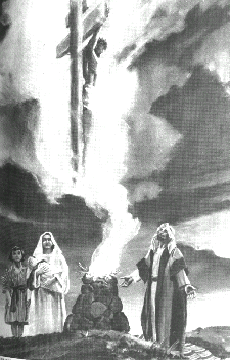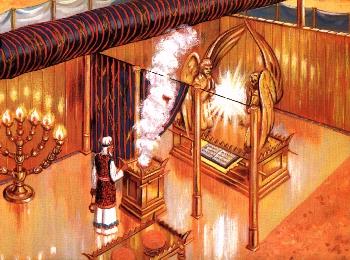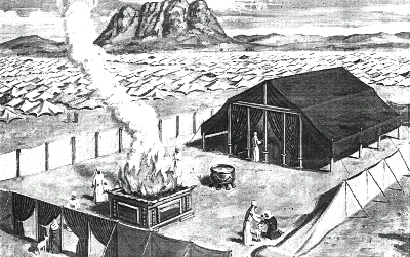Booklet
D
The Gospel in the Old Testament and the end-time
cleansing work of Christ
Supplement to Lesson 15
- 1. The
Gospel in the Old Testament
- 2. How
People Before the Cross Demonstrated Their Faith
in Christ
- 3. The
Significance of the Old Testament Sanctuary
Services
- 4. Three Steps
in the Atonement
- a. Sacrifice
- b. Intercession
- c. Cleansing
- 5. Biblical
Figures Which Illustrate Christ’s End-Time
Cleansing Work
- a. The Day of
Atonement
- b. The Pre-Advent
Judgment
- c. Preparations
for a Wedding
- d. Refining
of Gold and Silver
- 6. Where We Stand Today
- 7. How
We Arrive at the Date, October 22, 1844
- 8. The
Misunderstanding in 1844
- 9. The Close of
Probation
At no time in the world’s
history has anyone ever earned salvation by his own
works. In both Old and New Testaments, people were saved
by the grace of God and the merits of Jesus. The
following texts make it clear that people who lived
before the cross were saved on the same terms as were
people in New Testament times.
"I am not ashamed
of the gospel of Christ: for it is the power of God
unto salvation to every one that believeth; to the
Jew first, and also to the Greek." Romans 1:16.
"For unto us was
the gospel preached, as well as unto them."
Hebrews 4:2.
"For by the works
of the law shall no flesh be justified."
Galatians 2:16.
"Neither is there
salvation in any other: for there is none other name
under heaven given among men, whereby we must be
saved." Acts 4:12.
"But though we, or
an angel from heaven, preach any other gospel unto
you than that which we have preached unto you, let
him be accursed." Galatians 1:8.
The Old Testament itself teaches
salvation through Christ. The "scriptures"
spoken of in the following texts are the Old Testament.
These texts make it clear that the Old Testament
scriptures teach the same gospel of salvation through
Christ that we find in the New Testament.
"Christ died for
our sins according to the scriptures." 1
Corinthians 15:3.
"From a child thou
hast known the holy scriptures, which are able to
make thee wise unto salvation through faith which is
in Christ Jesus." 2 Timothy 3:15.
"Then he said unto
them, `O fools, and slow of heart to believe all that
the prophets have spoken: Ought not Christ to have
suffered these things, and to enter into his
glory?’ And beginning at Moses and all the
prophets, he expounded unto them in all the
scriptures the things concerning himself." Luke
24:25-27.
"All scripture is
given by inspiration of God, and is profitable for
doctrine, for reproof, for correction, for
instruction in righteousness." 2 Timothy 3:16.
The Bible presents one gospel from
Genesis to Revelation, one plan of salvation for
humanity. The Bible calls it "the everlasting
gospel" (Revelation 14:6), the "everlasting
covenant" (Psalm 105:10; Hebrews 13:20).
The Bible says that we are saved by
grace through faith. Faith, therefore, is the means by
which we take hold of God’s grace.
Faith always exhibits itself in
real and identifiable action. "I will shew thee my
faith by my works." James 2:18. Often the Lord has
asked His people to express their faith through the
performance of an action. Many of Christ’s miracles
occurred in response to an act of faith.
This principle helps us to
understand the purpose of the ceremonial ordinances of
the Old Testament. Performing those ceremonies did not
earn salvation for the Israelites, but served only as the
means whereby they were to demonstrate their faith in the
Saviour who was to come.
 Every sacrifice offered, every ordinance
performed, was to be an expression of faith in Christ.
"By faith Abel offered unto God a more excellent
sacrifice." Hebrews 11:4. "Through faith he
[Moses] kept the passover, and the sprinkling of
blood." Hebrews 11:28.
Every sacrifice offered, every ordinance
performed, was to be an expression of faith in Christ.
"By faith Abel offered unto God a more excellent
sacrifice." Hebrews 11:4. "Through faith he
[Moses] kept the passover, and the sprinkling of
blood." Hebrews 11:28.
Every element in the Old Testament
ritual system was specifically designed by Christ to
illustrate His own work in the plan of salvation. Every
lamb that was slain prefigured Christ, the Lamb of God,
who would be offered for the sins of the world.
Everything the priests did pointed to Jesus, our great
High Priest in the courts above.
By contemplating the meaning of the
ceremonies he performed, an Israelite could understand
the entire gospel of salvation. The gospel of Christ is
in the Old Testament illustrated just as clearly as in
the New Testament it is proclaimed.
The ceremonial system centered
around the sanctuary and its services. It should not
surprise us then that every major scene in the book of
Revelation is oriented with respect to the temple in
heaven where Christ is ministering for us. The heavenly
temple is specifically mentioned 14 times in Revelation
(3:12; 7:15; 11:1, 2, 19; 14:15, 17; 15:5, 6, 8; 16:1,
17).
Revelation is full of sanctuary
terminology. Twenty-eight times in Revelation Jesus is
called the "Lamb". References to sanctuary
furniture such as the candlesticks, the altar of incense,
and the ark of the testament are found throughout the
book. Other references to the temple in heaven include
Psalm 11:4; 18:6; Isaiah 6:1; Habakkuk 2:20; Malachi 3:1;
and Hebrews 8 and 9.

The tabernacle on earth was
patterned after the temple in heaven. It
consisted of two apartments, the Holy Place and
the Most Holy Place.
By studying the plan of salvation
as illustrated in the Old Testament sanctuary services,
we may learn much about the great work of atonement.
The word "atonement," or
at-one-ment, refers to the process whereby man is
reconciled to God. A study of the sanctuary reveals three
steps in the process: sacrifice, intercession, and
cleansing.

This step was symbolized in the Old
Testament by the daily slaying of animals. A perfect lamb
without blemish was required, and sacrificed in the
courtyard. Every drop of blood that was shed in those
rituals pointed to the sacrifice of Jesus for lost
mankind. His death paid the full price for our
redemption.
This step was symbolized by the
daily duties performed by the priests in the holy place,
or first apartment of the sanctuary. Incense was
continually offered before God, mingled with the prayers
of the saints. This represented Christ’s priestly
intercession for His people which He began after His
ascension to heaven. Through Christ’s first
apartment ministry the sinner’s guilt is pardoned,
and Christ’s righteousness is imparted to His
people.
The third step was illustrated once
each year in the Old Testament ceremonies. The tenth day
of the seventh month was called the Day of Atonement. It
was the day on which the sanctuary was cleansed. It was
considered the most solemn and significant event of the
year. On that day the whole congregation appeared before
the Lord that they might be made "at one" with
Him. Sins which had been brought to the sanctuary
throughout the year were figuratively removed from it on
that day. But those who failed to humble themselves
before God were cut off from the people.
On that day the high priest alone appeared
before God behind the veil of the Most Holy Place. With
him he took the blood of a goat and a censer of coals
from the altar of incense. This represented the final
phase of Christ’s work in the heavenly sanctuary,
performed in "the time of the end." The work of
atonement is not complete until the sanctuary is thus
cleansed.
Scripture references to the Old
Testament Day of Atonement include Leviticus 16 and
Leviticus 23:27-32. Information on the end-time cleansing
of the sanctuary is found in Daniel 8:14; Malachi 3:1-5;
and Hebrews 8 and 9.
Lesson 16 covers the subject of
Christ’s end-time cleansing work. But we would like
to preview the subject briefly here. At least four
different figures are used in the Bible to illustrate the
final, cleansing phase of Christ’s atoning ministry.
They are summarized below.
Since the Old Testament feasts such
as Passover and Pentecost illustrated and pointed forward
to events in Christ’s work of salvation, we should
also expect the Day of Atonement to point to a
significant aspect of Christ’s ministry. The
Biblical description of the Day of Atonement presents it
as a day of cleansing for the sanctuary and the people.
A second figure used in the Bible
to illustrate Christ’s end-time cleansing work is
that of a pre-advent judgment. That is, a judgment which
Christ performs before He returns at His second coming.
Lesson 16 presents the texts referring to this event,
which is often called the Investigative Judgment. It
involves an examination of the lives of all whose names
have ever been entered into the book of life.
Elsewhere in the Bible the
cleansing phase of Christ’s ministry is compared to
preparations made for a wedding. The wedding parables of
Jesus in chapters 22 and 25 of Matthew speak of an
essential preparation on the part of the those who are
invited to the wedding feast. Symbolically we are each
individually called to be guests at the wedding of Christ
and His church. The marriage appears in Revelation 19:7-9
just before Christ comes back to earth to receive His
bride. In Matthew 22:11 the king personally inspects each
guest to make sure they are each wearing the wedding
garment. Revelation 19:8 tells us that this white raiment
is "the righteousness of saints." Only those
who by God’s grace overcome their sins (Revelation
3:5) are clothed in the required garment. This
preparation and inspection of character before the
wedding illustrates the end-time cleansing ministry of
Christ.
A fourth Biblical description of
Christ’s end-time cleansing work is found in Malachi
3 where the Lord comes to His temple and sits "as a
refiner and purifier of silver: and he shall purify the
sons of Levi, and purge them as gold and silver." It
is encouraging to know that Jesus not only examines our
lives, but also works to cleanse us of the sins which may
beset us. The strongest influences of heaven are working
to help us separate ourselves from sin’s destroying
hold.
God is on our side. He wants us to
obtain the victory. It has been said that there are three
votes which determine each person’s eternal destiny.
Satan always votes against you. God always votes for you.
The deciding vote is left to you.
We now live in the period of
Christ’s ministry which the Bible depicts in the
above four ways. The cleansing of the sanctuary is going
on today. It began, according to prophecy, at the end of
the "2300 days" of Daniel 8:14. The first
"seventy weeks" of that prophecy pointed to the
time of Christ’s sacrifice on Calvary. The remaining
1810 years of the prophecy point to the time when the
cleansing of the sanctuary would commence: the autumn of
1844 (See lesson 14).
We have noted that every ceremony
which God gave to Israel had significance in illustrating
some aspect of Christ’s ministry. The first-month
feasts, also known as spring festivals (Passover, the
Feast of Unleavened Bread, the Wavesheaf Offering, and
Pentecost), all pointed to events connected with
Christ’s sacrifice and intercessory ministry. The
seventh-month feasts, or autumn festivals (Trumpets, the
Day of Atonement, and the Feast of Tabernacles), pointed
to events connected with the final phase of the atonement
and the eradicating of sin from the universe.
Christ’s fulfillment of the
events to which each of the spring festivals pointed took
place on the very date of the corresponding ceremonial
service in the Jewish calendar. In other words, He
actually died on Passover day, was raised on the day of
the wave sheaf offering, and the Holy Spirit was poured
out on the day of Pentecost. We therefore know that He
would begin the work to which the Day of Atonement
pointed on that date of the Jewish calendar in 1844,
which was October 22.
The disappointed expectations for
Christ’s return in 1844 were the result of a
misunderstanding as to which sanctuary was to be
cleansed. But before we criticize those believers we need
to remember that the prophet Daniel misunderstood the
same thing. Daniel received the vision of the 2300-day
prophecy in 551 B.C. But Gabriel did not provide a full
explanation of the prophecy until the first year of
Darius the son of Ahasuerus, which was 538 B.C. Chapter
nine reveals that during those 13 years Daniel held a
misunderstanding as to which sanctuary was to be
cleansed. His concern was for the temple in Jerusalem
which he hoped would soon be restored. He certainly did
not want to see it lay in ruins for 2300 years. That was
the reason for his great anxiety and earnest prayer.
William Miller began preaching on
the 2300-day prophecy in the year 1831. Until 1844 people
incorrectly assumed that the sanctuary to be cleansed was
the earth. Just like Daniel, for 13 years they
misunderstood which sanctuary was to be cleansed!
Because God may withhold the full
light of truth from His people for a time does not mean
that He is not leading them. He has a reason for all that
He does, and He unfolds His secrets as He sees best. Our
duty is to walk in the light as He reveals it, and He
will guide us into all truth.
The wedding parable in Matthew 25
indicates that salvation is offered for a limited time
only. In the parable, those who were prepared for the
bridegroom "went in with him to the marriage: and
the door was shut." After the door was shut no one
else who sought entrance was allowed in. They were too
late.
Jesus compared His coming to the
days of Noah. For 120 years people had opportunity to
respond to Noah’s invitation. But once the door was
shut, no one else could enter.
Jesus is now inviting all who will
respond, to allow Him to cleanse them from sin. He is now
pleading the merits of His own sacrifice on behalf of all
who will choose it. But when His ministry in the heavenly
sanctuary is finished and everyone on earth has either
cooperated with or rejected His atoning work, He will
then leave the sanctuary. His work of intercession
ceases. Those who during the time of probation have made
an entire consecration of their lives to Him are at that
time sealed from the power of Satan. They will sin no
more. But those who spurned God’s grace while Jesus
pleaded, will find no mediator when probation ends. They
had chosen to retain their sins, and their decision
cannot be reversed.
Revelation 15:5-8 describes the
scene after Jesus leaves the temple. The sanctuary is
empty; its activities have ended. The wrath of God is now
poured out upon the unrepentant. The plagues which then
will fall upon the world are described in Revelation 16.
But those who had made the Lord
their refuge will have His protection during the time of
trouble. See Isaiah 4:4-6; 26:20; and 33:16. The
beautiful ninety-first Psalm also describes the
protection to be enjoyed by the righteous during that
time. Take time to read and memorize these passages so
they will be in your heart to strengthen and encourage
you in the days ahead.